2. Huldrych Zwingli (1484 - 1531)
From his Birth to his Appointment in Zurich
Huldrych Zwingli was born on 1 January 1484 in Wildhaus (c. 50 km south of St. Gallen, situated in the top part of the Toggenburg). He had nine or ten brothers and sisters, at least two of whom died relatively early, and two of his sisters entered the convent. After school (among other things) in Basel and Bern, Zwingli studied from 1499 in Vienna and then from 1502 onwards in Basel, where he sat for his Master’s degree. Thomas Wyttenbach became the most important teacher for him in Basel. Following his studies of the “liberal arts” (liberales artes), Zwingli studied another half year of theology and from the summer of 1506 was pastor in Glarus, situated not all that far from Wildhaus.
Already early on, Zwingli took a stand on a political problem. The background
was the mercenary tradition widespread in the then Swiss Confederation.
This foreign military service (so-called “Reislaufen”) was
lucrative for the towns. Whoever put a proportion of the young men of
the town at disposal as mercenaries got money in the town funds. Under
consideration at this time in Glarus (1506) was the question of the direction
in which Glarus should orient itself and whom the mercenaries should
serve: Habsburg, France or the Pope. Zwingli fought on the side of the
Pope. He was able to understand the soldiers as a weapon of the Crucified
against the enemies of the Church – war was therefore a holy instrument.
In 1513 Zwingli was away as army chaplain and accompanied c. 500 Glarus
soldiers who were fighting in the papal army. The experiences that Zwingli
had in the war were to give him cause for thought. In 1515 the papal
army with its Glarus soldiers suffered a defeat and in Glarus itself
the mood changed in favour of the victorious French. This was a problem
for the Pope-supporting Zwingli. He left Glarus and in 1516 became a
lay priest in Einsiedeln, an old monastery and place of pilgrimage. In
the good two years in which Zwingli worked in Einsiedeln, the political
character of his activity, which had previously been a strongly determining
factor, faded into the background. His church activity as well as personal
and further scholarly studies came to the fore instead.
Then in 1516 Zwingli had a reformational breakthrough. He said of himself
that from 1516 he preached the Gospel. He read Scholastic works and the
Church Fathers and learnt Greek in order to be able to read the New Testament
in the original. Zwingli became an educated theologian. He also got to
know the philosophy of the famous Erasmus from Rotterdam. This impressed
Zwingli without his simply adopting it. And of what did his “Gospel” now
consist? It must not be asked whether the “knowledge of justification” present
in Luther is to be found in it, in order then to be able to call Zwingli’s
breakthrough Reformational. Rather, Zwingli went his own way. The Reformational
turn is to be seen in his thought in a clear turn towards the Bible and
indeed to “sola scriptura” – “Holy Scripture
alone.” This, however, was not a methodological decision. Zwingli
emphasised rather the authority of the Holy Scripture because it, and
not the Church in its clerical power, mediates the Gospel, the good news
of the God who favours humanity. This process of reformational recognition
was in the following years to be deepened and worked out more fully in
its content.
The Beginnings of the Reformation in Zurich
In Autumn 1518 Zwingli was appointed lay priest in Zurich. The main task was preaching. And he began with a peculiar feature. As a basis for his sermons he did not use the pericopic ordering, but rather interpreted the biblical scriptures in their continuity. Thus he opposed the dominance of the Church year and followed the Bible in its progress.
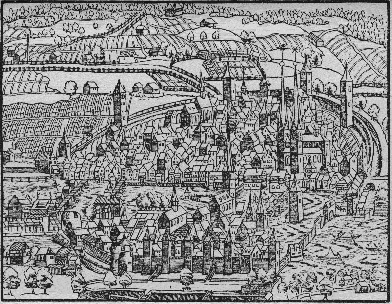
View from Zurich
After J. Stumpf’s Swiss Chronical. Zurich 1547
Zwingli’s knowledge of Scripture deepened throughout the years up to 1522. One topic of his sermons was his opposition to the Reislaufen. And this was successful, for in 1522 the Zurich Council forbade it. In the same year the public conflicts began. On 9 March 1522 a protest sausage-meal took place in house of the book printer, Christoph Froschauer, a protest because sausage was being eaten in Lent. Two smoked sausages were cut into pieces and distributed among the people present. Zwingli was there without participating in the sausage-meal. This first infringement of the lenten fast was followed by more in the following days. The whole thing became quickly known in Zurich. The Council began to intervene and started legal investigations. Only two weeks after the sausage-meal Zwingli preached on the subject of the problem of fasting. This sermon appeared in April 1522 under the title, “Concerning Freedom an Choice of Food.” Zwingli takes here an Evangelical understanding of freedom: Christians are released from all human commands and ordinances; human commands cannot demand unconditional obedience. The law of fasting is such a human, churchly statute. And because it has no godly authority behind it, which means no authority of the Bible, obedience to it need not be given. However, although Christians are free, this freedom is not to be used excessively because they do not live on it.
Zwingli’s Understanding of Freedom [They] had not so strong a belief in God, that they trusted alone
in him and hoped alone in him, listened alone to his ordinances
and will, but foolishly turned again to the devices of men, who,
as though they desired to improve what had been neglected by God,
said to themselves: “This day, this month, this time, wilt
thou abstain from this or that,” and make thus ordinances,
persuading themselves that he sins who does not keep them. This
abstaining I do not wish to condemn, if it occurs freely, to put
the flesh under control, and if no self-confidence or vainglory,
but rather humility, results. See, that is branding and injuring
one’s own conscience capriciously, and is turning toward
true idolatry… (Zwingli, “Concerning Choice and Liberty respecting Food,” cited from S.M. Jackson ed., The Latin Works and the Correspondence of Huldreich Zwingli, vol. 1, New York: G.P. Putnam’s Sons, 1912, pp85-85, 104). *** Questions for further Work 1. Why does Zwingli here oppose the law of fasting? And what does
the law of fasting have to do with faith? 2. Does Zwingli consider fasting to be unchristian? 3. What is the basis of Freedom? 4. Why should Christians not exercise their freedom in every case?
|
The situation in Zurich intensified further. The town council ascribed
to itself and not to the Bishop of Contance the power of decision. After
a hearing and a provisional prohibition of the breaking of the Lenten
fast, a disputation was fixed for the beginning of 1523. There the town
council intended to decide, and the Holy Scripture was named as the criterion
for the decision. Thus Zwingli’s Reformation perception achieved
its breakthrough in Zurich. Besides the breaking of Lent there were further
conflicts. Zwingli criticised the veneration of saints thereby giving
rise to conflicts with the mendicant order. The council also requested,
however, that the mendicant order preach only in accordance with Scripture.
Further, Zwingli called for celibacy to be given up and for Luther, who
was under imperial ban, to be protected. Likewise, Zwingli opposed Mary’s
mediation of salvation.
In August 1522 Zwingli renounced his allegiance to the Roman Church because
it grounded itself only in human laws. Erasmus was horrified by such
resolute words. Zwingli grew more and more into the role of the predominant
preacher in Zurich. He himself lived with his wife from 1522, first officially
marrying her, however, in 1524. They were to have four children.
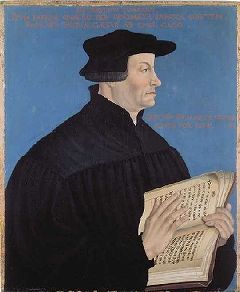 On
29 January 1523 the first Zurich disputation took place. Ultimately at
stake was whether arguments against Zwingli’s sermon could be found.
The council intended to decide on the basis of the Bible. Approximately
600 participants came to the town hall. A legation came from Constance
under leadership of Johannes Faber, who was not supposed to dispute,
however, but only to protest and act as observer. What was at stake above
all in the discussion was the problem of authority: who is entitled ultimate
authority on earth? By midday the council had already heard enough and
resolved that Zwingli could not be accused of any heresy but moreover
that even the other preachers should preach on the basis of Holy Scripture.
Zwingli formulated 67 articles or conclusions for the disputation. Two
catchphrases serve as a summary: solus Christus, Christ alone, and sola
scriptura, the Bible alone.
On
29 January 1523 the first Zurich disputation took place. Ultimately at
stake was whether arguments against Zwingli’s sermon could be found.
The council intended to decide on the basis of the Bible. Approximately
600 participants came to the town hall. A legation came from Constance
under leadership of Johannes Faber, who was not supposed to dispute,
however, but only to protest and act as observer. What was at stake above
all in the discussion was the problem of authority: who is entitled ultimate
authority on earth? By midday the council had already heard enough and
resolved that Zwingli could not be accused of any heresy but moreover
that even the other preachers should preach on the basis of Holy Scripture.
Zwingli formulated 67 articles or conclusions for the disputation. Two
catchphrases serve as a summary: solus Christus, Christ alone, and sola
scriptura, the Bible alone.
The second and third articles of the 67 articles or conclusions run as follows: The summary of the gospel is that our Lord Christ, true Son of God, has made known to us the will of his heavenly Father and has redeemed us from death and reconciled us with God by his guiltlessness…Therefore, Christ is the only way to salvation of all who were, are now, or shall be. (Cited from Zwingli, Writings, vol. 1, “The Defense of the Reformed Faith,” trans. E.J. Furcha, Pennsylvania: Pickwick Publications, 1984). *** Questions for further Work 1. What are the two dimensions which Zwingli calls the “chief
matter of the Gospel”?
2. What does Jesus Christ say to us about God?
3. Why is Christ the only way to salvation? |
Theological Deepening and Conflicts
The year 1523 was for Zwingli characterised by a theological deepening of his thoughts. These were concerned, for example, with the sharp distinction between God and the creature, the understanding of sin, the doctrine of the Church, the meaning of justice and thus also the relation between state and Church. But his new thinking in respect of the Lord’s Supper was also already becoming clear – Zwingli no longer saw it as a means of salvation. All in all, it can be seen that Zwingli went his own independent way of reformation here. He was neither Luther nor Erasmus but developed an independent theology that could take elements from both.
On Faith and the Forgiveness of Sin But we said that it is by faith that sins are forgiven. By this
we simply meant to affirm that it is faith alone which can give
the assurance of forgiveness. (Zwingli, “An Exposition of the Faith,” cited from The Library of Christian Classics, vol. 24, “Zwingli and Bullinger,” trans. G.W. Bromiley, p268f. London: SCM). *** Questions for further Work 1. What misunderstanding of faith is Zwingli fighting against?
2. How does humanity gain certainty of the forgiveness of sins?
3. Can one be sure of one’s faith?
|
Besides this theological deepening, the Reformation established itself
in everyday life. The monasteries emptied. Many priests married. The
church liturgy changed and simplified greatly. In September 1523 iconoclastic
activities increased, leading to disputes. In October 1523 there was
a second Zurich Disputation concerning the reform of the church service
and the pictures in the Church. The result was a recommendation not to
proceed by the use of power but to persuade with arguments. However,
it became clear in the Disputation that the priesthood as a whole was
badly educated in theology. And it was recognised that Zwingli and others
with him stood between two wings – believers of the old faith or
conservatives on the one side and radicals on the other.
In the course of the rest of the year 1523 and finally in 1524, Zwingli’s
position established itself more and more. The conservatives, i.e. the
earlier Catholical inclined opposition, broke apart and lost the support.
At Pentecost in 1524 the council decreed the removal of pictures, crucifixes,
statues and wall-representations. However, regarding the form of the
church service, the council hesitated. This provoked the radicals in
such a way that a break with them began to develop.
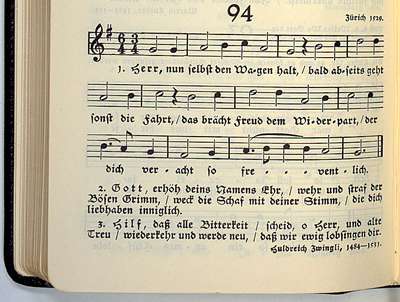
(For further information please click on the picture)
This break took place definitively in 1525 as the radicals set up their
own small community outside Zurich in the village Zollikon under the
leadership of Konrad Grebel. Grebel’s ideal was a community of
believers, and thus child-baptism became a problem. Already in 1524 refusals
of baptism had occurred against the will of the council, which arranged
the baptism of new-borns. A disputation in 1524 had led to no result
and so the establishment of the new community in which only adult-baptism
(therefore rebaptism) was carried out, was a logical consequence.
At times Zwingli himself had had doubts about child-baptism. However,
in the context of the Anabaptists, for whom baptism meant membership
in a community that turned its back on the world, Zwingli developed a
theology of baptism of a wholly different nature. In the first place
it opposed the Roman view, which Luther also followed at least in part,
that baptism is not a means of grace and does not effect anything of
itself. The forgiveness of sins can be experienced on the basis of the
divine promise, which is professed in the sermon. Baptism does not forgive
sins and nor does the baptismal water. It has no supernatural significance.
This united Zwingli with the Anabaptists. Nevertheless, Zwingli stood
by child-baptism, although it cannot show the commitment involved in
baptism. And indeed because it becomes clear in the Bible that even children
of Christians already belong to God and because in the Old Testament
infants are also circumcised, baptism is thus seen as a parallel to circumcision.
Besides, the practice of adult-baptism leads to isolation and to a community
that considers itself free of sin.
That which happened besides the theological discussion in the following
years between the authorities and the Anabaptists has not become a sign
of glory for the Reformation –Anabaptists were persecuted, driven
out and some of them even murdered.
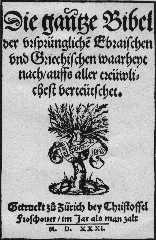 Further
writings of Zwingli emerged, for instance “The Shepherd” in
1524, in which Zwingli depicts the evangelical preacher as the faithful
shepherd in contrast to evil counterexamples. A year later the “Commentarius
de vera et falsa religione” – a commentary on true and false
religion appeared, in the 29th chapter of which Zwingli describes the
main items of the evangelical teaching. The commentary can be regarded
as Zwingli’s main work. Early in the year 1525 the so-called “Prophezei” began,
an exegetical training course in which the Bible was interpreted. This
became an obligatory activity for pastors. As a result of these biblical
interpretations, the Zurich Bible was available in 1531. In Zurich in
1525 a new liturgy for the Easter service was introduced, characterised
by clarity and simplicity. At the centre stood the sermon; the liturgical
singing and organ disappeared; and the instruments for the Lord’s
Supper were made out of wood.
Further
writings of Zwingli emerged, for instance “The Shepherd” in
1524, in which Zwingli depicts the evangelical preacher as the faithful
shepherd in contrast to evil counterexamples. A year later the “Commentarius
de vera et falsa religione” – a commentary on true and false
religion appeared, in the 29th chapter of which Zwingli describes the
main items of the evangelical teaching. The commentary can be regarded
as Zwingli’s main work. Early in the year 1525 the so-called “Prophezei” began,
an exegetical training course in which the Bible was interpreted. This
became an obligatory activity for pastors. As a result of these biblical
interpretations, the Zurich Bible was available in 1531. In Zurich in
1525 a new liturgy for the Easter service was introduced, characterised
by clarity and simplicity. At the centre stood the sermon; the liturgical
singing and organ disappeared; and the instruments for the Lord’s
Supper were made out of wood.
Zurich found itself largely isolated inside the Swiss Confederation. It was no longer invited to the Tagsatzung of the Swiss Confederation. Even so, the Reformation gained the upper hand in several places, including St. Gallen, Schaffhausen, Basel and Bern. The Reformation had also established itself in Constance. Zurich formed an alliance with these towns, agreeing upon the so-called “Christian Civil Rights (Das Christliche Burgrecht).” This threatened those cantons living in the milieu of the Christliche Burgrecht who were still Catholic. These also merged to form an alliance called “Christian Union (Christliche Vereinigung),” through which they also gained the Habsburgs as an ally. After a time of threat, the war finally broke out. 30 000 soldiers of the Burgrecht stood against c. 9000 Swiss members of the Christliche Vereinigung. But since only a part of the Burgrecht were committed to the war and the Catholic Swiss were hopelessly inferior, an agreement was quickly reached – the first Peace Treaty of Cappel 1529. From the perspective of the Burgrecht and therefore also of Zwingli, the result was modest because the mercenary practice in the Swiss towns continued to be possible. However, the first Peace Treaty of Cappel did make the Reformation possible in further parts of Switzerland.
Apart from externally directed disputes, there was also opposition within Zurich itself both political and ecclesiastical. Political opposition consisted above all in the traders, the nobility and others, who had a large interest in the Reislaufen and in the undisturbed running of the economy, and church opposition in many believers of the old faith who demanded the reintroduction of the daily Mass.
From 1523, Zwingli developed his own understanding of the Lord’s Supper. While Luther took as his starting point the fact that bread and wine become the body and blood of Christ in believers, Zwingli emphasises that bread and wine signify the body and blood of Jesus Christ, who was given up once-for-all on the cross and who is present for believers in the Holy Spirit. The elements of bread and wine do not guarantee the forgiveness of sins, but are a remembrance of this happening. Whoever celebrates the Lord’s Supper confesses that our present is transformed through the power of the reconciliation which happened on the cross
On Zwingli’s Understanding of the Lord’s Supper Seventh, I believe, indeed know, that all the sacraments are so far from conferring grace, that do they do not even bestow or administer it. …As grace is produced or given by the divine Spirit – I use the word in the Latin sense, that is I employ the expression “grace” to mean forgiveness, mercy and free favour – so this gift falls to the Spirit alone. However, the Spirit needs no guide or medium. That is, it is itself the power and carrier by which all is conferred; it is not in need of being conferred itself. We never read in the Holy Scriptures that that which is visible, which the sacraments are, confers the Spirit with certainty. Rather, if the visible were ever bound with the Spirit, the Spirit was the carrier and not the visible element. (Zwingli, Account of the Faith, translated from the German Rechenschaft ueber den Glauben, in Zwingli Schriften Bd. IV, 113). And because this re-membrance is a thanksgiving and a rejoicing in the Almighty on account of the good work which he has accomplished for us through his Son, who appears in this feast, supper or thanksgiving, witnessing to the fact that he belongs to those who believe that they are redeemed by the death and blood of our Lord Jesus Christ. (From H. Zwingli, Action or Custom of the Lord’s Supper,
translated from the German Aktion oder Brauch des Nachtmahls, in
Huldreich Zwinglis saemtliche Werke Bd. IV [CR 91], Leipzig 1927,
1-24, 15). *** Questions for further Work 1. Why don’t the sacraments, according to Zwingli, confer
grace of themselves?
2. What kind of understanding of “the visible” can
be recognised here?
3. What is the role of the Holy Spirit?
4. What happens in the Lord’s Supper? What does it affect? 5. Is God present in the Lord’s Supper?
|
On the basis of their different their understandings, Luther and Zwingli could not come to an agreement with one another. Luther saw in Zwingli an apostasy from the Reformation, a Spiritualist. And Zwingli had the impression that Luther got stuck at half way. Both composed a series of conflicting texts on the Lord’s Supper, in part also consciously against one another (e.g. Luther, Against the heavenly Prophets, on the Pictures and Sacraments [1525]; Zwingli, a Clear Teaching on the Last Supper of Christ [1526]; Luther, that the Words of Christ “this is my body etc.” still stands firmly against the Adventists [1527]; Zwingli, that the Words “this is my body” etc. will have the old sense eternally [1527]). Under the pressure of Prince Philip of Hesse a religious colloquy took place in Marburg in October 1529. This was ultimately a failure, for Luther and Zwingli could agree on all points but not on the Lord’s Supper. However, it might be true to say that in the understanding of the Lord’s Supper conflicts are brought to light (which would otherwise still be concealed). (Picture: Marburg Colloquy)
In Augsburg in 1530 the Diet of Augsburg took place, at which the Emperor wanted to achieve a reestablishment of unity in the Church. The “Confessio Augustana” (the Augsburg Confession) composed by Philipp Melanchthon, which became the characteristic confession of the Lutheran Church, was there read out. Zwingli also submitted a confession – “Fidei ratio” (the ground of faith). In contrast to the Augsburg Confession which was aimed at reconciliation and rapprochement, Zwingli here explained his interpretation of the Gospel in a very aggressive manner and from the Word of God demonstrated unequivocally to the Emperor his responsibility, his defects and his limits.
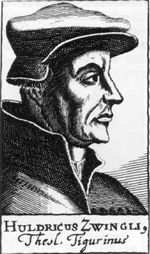 Zwingli
was further engaged in Zurich politics and many of his ideas regarding
Zurich’s foreign policy were taken up by the Peace Treaty of Cappel.
But Zwingli could not particularly influence the course in its concrete
developments. And as a result, he found his own political position in
Zurich less and less influential. He felt that he was left in the lurch,
and threatened in 1531 to resign, a move which was only prevented with
difficulty. The dispute between Zurich and those allied with it, and
the other towns, however, still carried on. For by the end of 1530 the
Reformation had only been able to establish itself in Switzerland to
a small extent. As a result, Zurich put on the pressure, indeed in 1531
with a foodstuffs blockade that came ultimately to nothing, and which
Zwingli moreover did not want. In reaction the five Inner Swiss (Catholic)
towns declared war on Zurich and at Cappel. On 11th October 1531 c. 3500
armed men from Zurich were devastatingly defeated by double as many Inner
Swiss. In less than an hour 500 men from Zurich fell, Zwingli among them,
as opposed to only 100 Inner Swiss.
Zwingli
was further engaged in Zurich politics and many of his ideas regarding
Zurich’s foreign policy were taken up by the Peace Treaty of Cappel.
But Zwingli could not particularly influence the course in its concrete
developments. And as a result, he found his own political position in
Zurich less and less influential. He felt that he was left in the lurch,
and threatened in 1531 to resign, a move which was only prevented with
difficulty. The dispute between Zurich and those allied with it, and
the other towns, however, still carried on. For by the end of 1530 the
Reformation had only been able to establish itself in Switzerland to
a small extent. As a result, Zurich put on the pressure, indeed in 1531
with a foodstuffs blockade that came ultimately to nothing, and which
Zwingli moreover did not want. In reaction the five Inner Swiss (Catholic)
towns declared war on Zurich and at Cappel. On 11th October 1531 c. 3500
armed men from Zurich were devastatingly defeated by double as many Inner
Swiss. In less than an hour 500 men from Zurich fell, Zwingli among them,
as opposed to only 100 Inner Swiss.